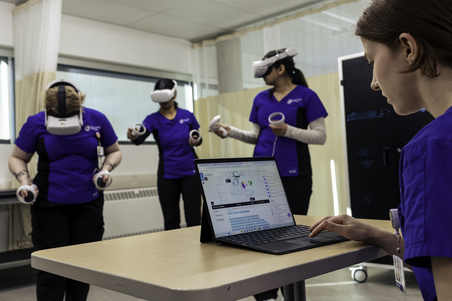3 Reasons Your First-Term Nursing Students Need VR Simulation & How to Start This Fall

Table of Contents
Name of the heading
1- Start your table with the syntax {start-table}
2 - Add an H3 Heading to create a new column (this will be the column title)
3 - List cells as bullet points in a List element
4 - End your table with the syntax {end-table}
Over 50% of nurses have been involved in errors, with 65% of those errors tied to poor clinical judgment, according to the National Council of State Boards of Nursing.
Without early development of clinical judgment, patient safety is at risk, and nurse learners are underprepared for clinicals.
Yet in many programs, it doesn’t become a true focus until clinical placements or upper semesters. Not because educators don’t value it. They do; they know how important it is. But when they’re juggling growing student needs, high student-to-faculty ratios, and a mountain of content to cover, it’s hard to have the resources to scaffold learning so precisely.
But this early practice gap has implications. Alarmingly, over 50% of student nurse errors involve medications (Silvestre & Spector, 2023).
Learners freeze when faced with unexpected patient cues. They overlook allergy checks or rush past barcode scanning—not out of carelessness, but because they haven’t yet developed the critical thinking skills to recognize risks, prioritize safety steps, and make confident clinical decisions. They need a safe space to build that clinical judgment “muscle.”
That’s where immersive VR simulation comes in.
Here are three reasons your students need VR simulation in their first term—and how to get started this fall.
Why First-Term Nursing Students Need VR Simulation
1. VR Works SIMbiotically Alongside Other Modalities
A SIMbiotic approach combines VR’s immersive clinical judgment practice with the tactile skill-building of manikins, providing a comprehensive learning experience.
Nicole Manley, MSN, RN, CHSE, CA-SANE, Director at University of Texas, shared insight from her simulation experience: “Oftentimes in simulation, students get very focused on tasking—doing the IV start, giving a medication—and they really don’t understand the why or their priorities. The VR scenario gives them a chance to understand what they're doing, the order of the process they’re completing on the patient, and work through all that before they get to the manikin-based simulation.”
UbiSim’s Type II Diabetes: Safe Medication Administration scenario lets learners practice identifying abnormal blood glucose signs, safely administering insulin, and communicating effectively—all essential skills before applying hands-on med administration in the skills lab.
2. VR is a Core Learning Tool, Not Just a Lab Activity
VR simulation is far more than a “lab activity” or a tool reserved for sim days or upper-level clinical placements. To truly build strong clinical judgment, VR needs to be integrated across the entire nursing curriculum from day one, giving students consistent, immersive opportunities to think, decide, and reflect in realistic scenarios. This continuous exposure helps learners become more and more capable of using clinical judgement.
Take UbiSim’s Alzheimer’s Disease: Safe Medication Administration scenario. Students care for a 68-year-old patient experiencing agitation and refusing care. They are put into a realistic situation where they must use empathy while also attempting to administer meds safely, layering safety protocols with person-centered care. With integrated barcode scanning in UbiSim, they do it all in alignment with the “5 rights of medication administration.”
3. VR Has the Potential to Reduce “Reality Shock” in Clinical Rotations
Many nursing students start clinical rotations as early as their first or second semester, especially in accelerated programs where real-world patient care begins alongside foundational coursework. This early exposure can be overwhelming, leading to “reality shock,” or the discrepancy between what they think being a nurse is and what it really is.
In UbiSim’s Post-Op Hip Arthroplasty: Safe Medication Administration scenario, learners care for a patient recovering from hip surgery. They must manage pain effectively, monitor for post-op complications, and safely administer medications—all while practicing calm, clear communication with their virtual patient. The chance to do it in VR offers learners repeated practice in a psychologically safe space. They can learn from their mistakes without becoming a patient harm statistic, building competence and confidence.
How to Start with VR Simulation This Fall
You don’t have to wait until sim days or upper-level courses to bring VR into your program. In fact, the most successful nursing programs scaffold immersive simulation from the very first week, using VR as a flexible, repeatable tool to build clinical judgment.
Build a Term-by-Term Plan
From Fundamentals to Med-Surg, VR scenarios meet students exactly where they are.
First Term
In the first term, learners need structure, repetition, and reassurance. VR gives them space to build familiarity with clinical environments, practice communication, and gain exposure to safe medication administration—all before setting foot in clinicals.
Use pre-built tutorials to guide learners through the essentials:
Terms 2 & 3 Scaffold Didactic
By the second and third terms, students face more complexity: applying theory in real time, interpreting labs, and making clinical decisions under pressure. VR helps bridge the gap with immersive Med-Surg scenarios, therapeutic communication practice, and customizable EHRs that mirror real clinical workflows.
More complicated mer-surge II scenarios:
UbiSim’s immersive VR simulation platform brings lifelike patient care into the classroom. Rather than wait for students to learn (and potentially make costly errors) with real patients, VR sim becomes the safe space to practice nursing before treating real patients. UbiSim gives nurses experience in treating diverse patients and conditions so they can build clinical judgment, teamwork, and communication skills. The result? Confident nurses with a heart for patient-centric care who are ready to succeed.
Give learners scaffolded tools to grow. Their future preceptors will thank you when students enter clinicals with confidence, competence, and sound clinical judgment.
References
National Council of State Boards of Nursing. (2018). The NCSBN national simulation study: A longitudinal, randomized, controlled study replacing clinical hours with simulation in prelicensure nursing education. https://www.ncsbn.org/public-files/Research/SimulationStudy_Web.pdf
Silvestre, J. H., & Spector, N. (2023). Transforming nursing education to improve medication safety: A regulatory perspective. Journal of Nursing Regulation, 14(1), 50–57. https://doi.org/10.1016/S2155-8256(23)00026-0
FAQs
Heading 1
Heading 2
Heading 3
Heading 4
Heading 5
Heading 6
Lorem ipsum dolor sit amet, consectetur adipiscing elit, sed do eiusmod tempor incididunt ut labore et dolore magna aliqua. Ut enim ad minim veniam, quis nostrud exercitation ullamco laboris nisi ut aliquip ex ea commodo consequat. Duis aute irure dolor in reprehenderit in voluptate velit esse cillum dolore eu fugiat nulla pariatur.
Block quote
Ordered list
- Item 1
- Item 2
- Item 3
Unordered list
- Item A
- Item B
- Item C
Bold text
Emphasis
Superscript
Subscript
Explore more

From 30 Minutes to 3: How AI Enhanced Analytics Transforms Debriefing Preparation
AI Enhanced Analytics: Scenario Performance Data now available in UbiSim's Version 1.19
.jpg)
Behind the Scenes: How We Brought Incisions & Dressings to Life in VR
How the UbiSim team built a VR system displaying 300+ distinct incision states—balancing clinical accuracy, technical constraints, and nursing education needs.
.jpg)
Step Inside the Room of Errors: Playful Exploration, Serious Skills
Learn how UbiSim's Room of Errors transforms nurse training through investigative play. Students spot hidden safety risks and build situational awareness.




